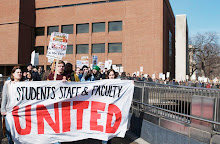On the State of the U address:
http://www.mndaily.com/2010/04/06/bruininks-outlines-cost-cutting-state-u
Last week the Daily interviewed Bob Bruininks. You can read the short version here:
http://www.mndaily.com/2010/04/07/state-university
For the full version, with audio:
http://www.mndaily.com/blogs/unfit-print/2010/04/09/interview-bob
And an excellent investigative piece, with the following highlights:
According to a September report from the Future Financial Resources Task Force, the University must “narrow the scope” of its mission if it is to remain viable in the increasingly competitive arena of higher education. Last fall, Senior Vice President and Provost Tom Sullivan sent a letter to the dean of each college, instructing them to create a “blue ribbon” committee. Among the questions Sullivan asked each group to consider: “What programs should be discontinued or eliminated?”
In October, Bruininks established the Advancing Excellence Steering Committee, charged with guiding the decisions that will soon be made about the University’s future. In an e-mail obtained by the Daily, Bruininks told the committee, “We have just 12 months to 14 months to be prepared to publicly articulate our priorities and needs.”
With the immediate and lasting issues clear, Bruininks sent an e-mail to 23 University leaders establishing the Advancing Excellence Steering Committee. Working from the framework provided by the Future Financial Resources Task Force and populated primarily by administrators — including 13 vice presidents and three deans — the committee is focusing on a variety of areas, among them undergraduate and graduate education, the future of the health sciences, research and long-term financial planning. Bruininks laid out a threefold purpose of the committee: provide University-wide leadership, identify and address priorities and policy issues and communicate with units to ensure adequate consultation while sharing the results of the efforts of the committee. “We face difficult decisions involved in setting priorities, allocating limited resources and strengthening some academic programs while reducing, consolidating or eliminating others,” the e-mail said.
Around that same time, blue ribbon committees in every college were setting out to model a 2.75 percent budget reduction for 2010-11. They were asked to consider in their planning which programs should be maintained or strengthened and which should be dramatically reduced or eliminated. The recommendations were passed along to deans for use in ongoing annual budget discussions with the University’s trio of senior vice presidents.
Computer science professor Joe Konstan was a part of the Institute of Technology’s blue ribbon committee. As he went through the process of trying to find fat that could be trimmed out of the college’s 2010-11 budget, Konstan ended up frustrated. “We looked at the data and said, ‘We’re pretty lean, and we’re doing really well,’ ” he said.
Liberal Arts’ “CLA 2015” was the only blue ribbon committee to publicly release its recommendations. It laid out $5.58 million of cuts, but no specific departments or programs were targeted...The committee reported to CLA Dean Jim Parente that the college could not sustain another round of cuts of the same magnitude and still continue to effectively operate all of its units.
And the CLA committee was not alone. “I came away feeling a big chunk of the solution isn’t going to be deciding we can do things a bit more efficiently here or there, but deciding there are substantial chunks [of the University] that, as much as we can do them well, we just can’t afford to do,” Konstan said of his involvement on the IT blue ribbon committee.
Provost Tom Sullivan said the Steering Committee is not a decision-making body, nor will it recommend individual programs or departments for reduction or discontinuation. Potential program changes filter through Sullivan regardless, with final authority designated to the Board of Regents. Sullivan said decisions will emanate from a groundswell, bottom-up process, but there are faculty members who wonder if their ideas will be given full weight.
“The real question is … will they be able to receive all of the information in all of its detail and subtlety at the top?” asked William Beeman, an anthropology professor and faculty senate member. He said many in the senate classify the decision-making at the University as top-down, just the opposite of what Sullivan describes. “There’s some suspicion among faculty members … that many of the decisions will be made in a top-down manner and that the consultation is largely cosmetic.”
As long as the economy thrived and states were able to subsidize growth, schools were able to expand while simultaneously supporting programs that lacked enrollment or distinction. State support dipped in the early 2000s but rebounded to reach an all-time high in 2008. This time, the precipitous drops projected in state appropriations likely won’t be recouped for some time; Bruininks said they may never return to pre-recession levels.
Whatever the reason for the stagnation of government money, the burden has shifted to students. In 2010, tuition overtook state support as the University’s largest revenue stream. In-state tuition surpassed $10,000 and has increased over 100 percent since 2001. When tuition increases offset decreases in state appropriation, the money isn’t always plowed back to the students. In a February memo to Bruininks, the faculty senate committee on finance and planning said: “It also appears the added [tuition] money will be controlled by central administration rather than the schools and colleges. The increases will have to be used to offset state budget cuts and therefore will not be available for instructional purposes.” Still, for the foreseeable future, tuition is the most promising candidate for bolstering revenue, according to the Future Financial Resources report. The gap between rising tuition and stagnated state money will likely only protract further.
http://www.mndaily.com/2010/04/05/steering-through-storm
Sunday, April 11, 2010
Subscribe to:
Post Comments (Atom)


No comments:
Post a Comment